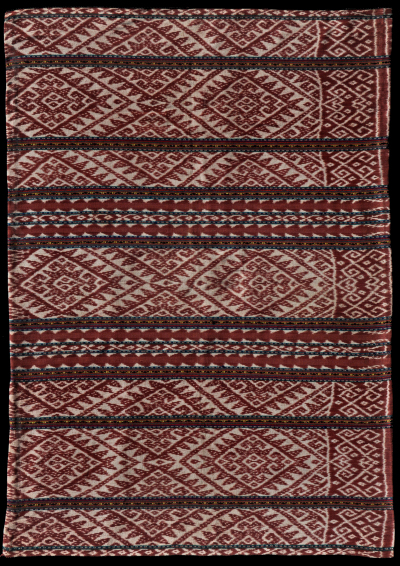| |
 
 | | | |
191 Timor, West Timor
Tais (sarong)  
| | Locale: | Amarasi, Oekabiti clan. | | Period: | 1930-1950 | | Yarn: | Cotton, commercial, fine | | Technique: | Warp ikat | | Panels: | 3 | | Size: | 72.5 x 107 cm (2' 4" x 3' 6") LW: 1.48 | | Weight: | 445 g (15.7 oz), 287 g/m2 (0.94 oz/ft2) | | Design: | Entire field decorated with ikated bands in white on morinda red, showing the kai e'ne or kaif motif that stands for connection to the ancestors, in a form that is typical for the Oekabiti clan. The middle panel carries a single kai e'ne, the two side panels each one whole and two halves turned outward. Narrow accent stripes in black and white sotis (float weave), pinstripes in green and red pred-dyed commercial yarn - a common feature in Timorese cloths since the early 20th C. | | Comment: | Excellent example of a traditional Amarasi ceremonial sarong. Forms a pair with the man's blanket in our collection, PC 192. Both stand out by their tight patterning, indicating the hand of a master weaver. The treatment of the motif is identical, so is the tonality of the morinda. The three panels have been joined so carefully that the seam is barely visible, and more easily discovered by stroking the cloth. Clearly a very lightly used piece in excellent state of preservation, showing markedly fewer signs of wear than the male half of the pair. | | Background: | Chapters on Timor and West Timor. | | Exhibited: | Timor: Totems and Tokens, Museu do Oriente, Lisbon, 2019/20. | | Published: | Ikat Textiles of the Indonesian Archipelago, 2018.
| | Compare: | 192 207 | | Sources: | Very similar to Amarasi tais from Oekabiti in Barnes and Hunt Kahlenberg, Five Centuries of Indonesian Textiles, p. 334; and to Yeager and Jacobson, Textiles of Western Timor, Plate 8. Characteristic fine stripes in commercial yarn that separate the ikated bands very similar to those in detail shots on Plates 6 and 7. Also similar to somewhat longer sarong in Khan Majlis, Woven Messages, Fig. 252; same kaif pattern, but with nine wide ikated bands instead of seven. Very similar sarong tais worn by high class women on her 'coming out' ceremony after childbirth on early 20th C. photo in Gittinger, Splendid Symbols, Fig. 9. | | |

©Peter ten Hoopen, 2025
All rights reserved.
|
|


